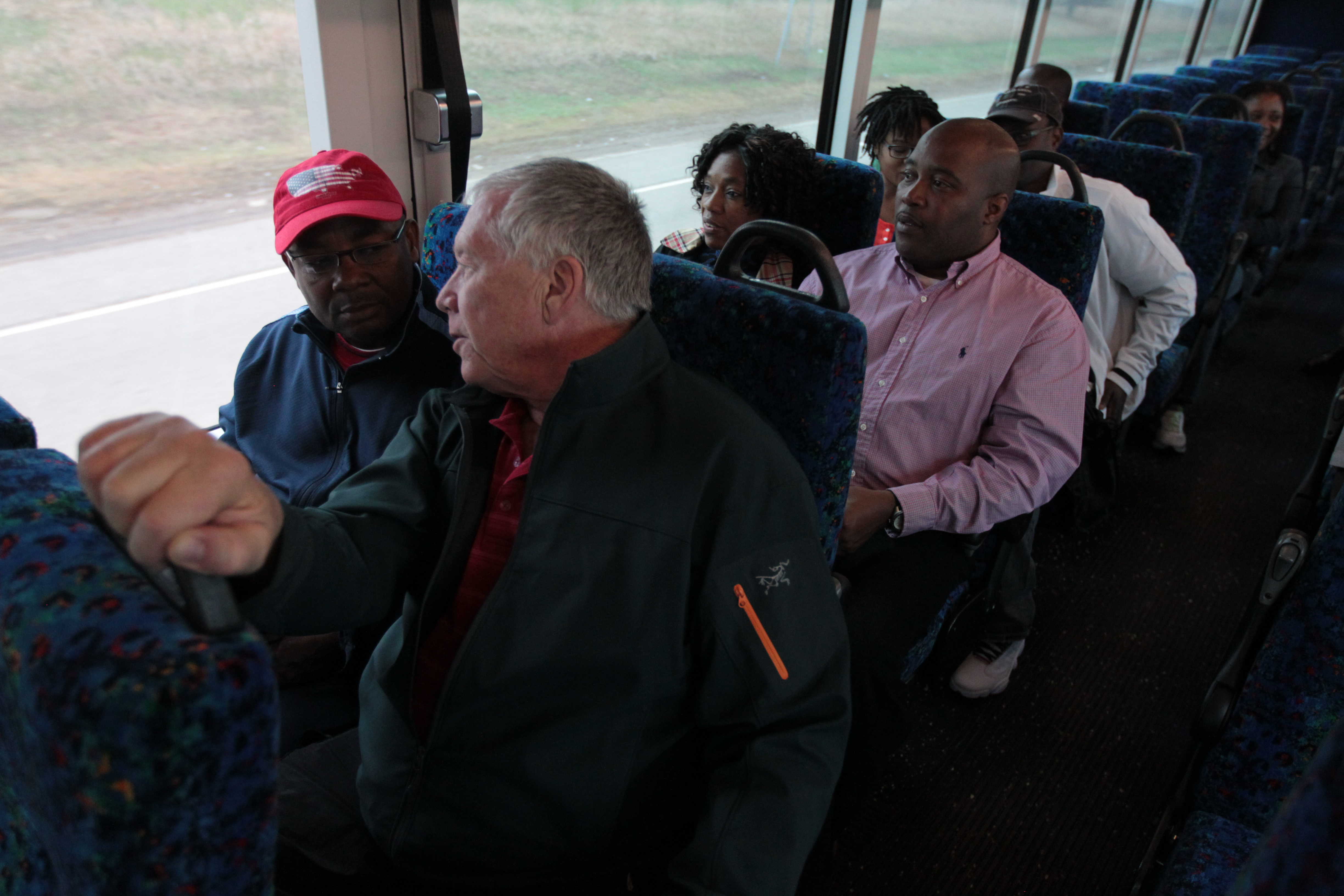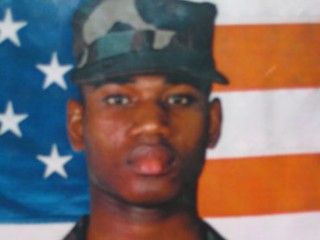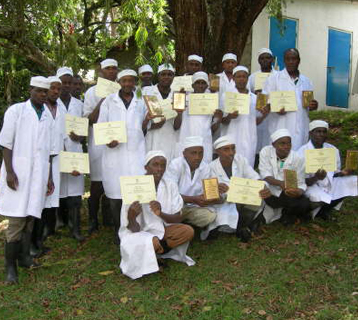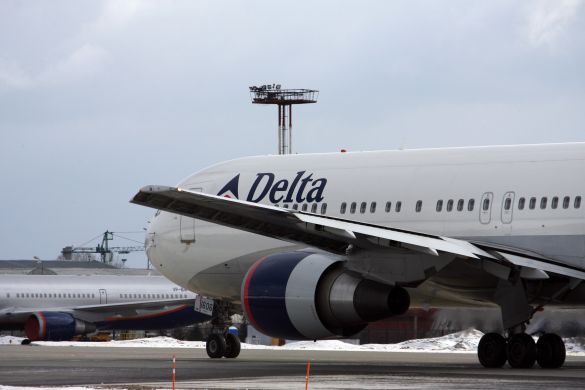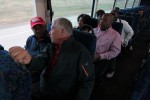
Editor’s note: Our publisher, Tom Gitaa, was last weekend part of a group of community leaders and organizers that were given a tour of the proposed Bottineau Transitway. He shares his first first person experience of the daylong tour organized byACER of Brooklyn Park. Throughout the year, we will be publishing stories on the community engagement aspects of the Bottineau Transitway as it relates to the African immigrant community where it will pass. 40% of our print newspaper readership is in the Transitway, so this is of importance to our readers. Please read our first story from last month about the transitway here.
The call came through around 2pm last Friday. I was on a conference call with a client so I let it go to voicemail. It was Wynfred Russell. He is the executive director of ACER (African Career, Education & Resource, Inc.), a Brooklyn Park nonprofit. He was reminding me the next day was the daylong tour of the proposed Bottineau transitway. I had it in my calendar but for some reason I had assumed it was on a weekday and not a weekend. I normally run two marathons during the year and practice season is in high gear around this time of year. Actually runners in Minnesota have been lucky this past winter season and we have been practicing all winter outside and Saturday is an important day for me as far as getting ready for the marathons go.
For most marathon runners, we have what we call the “long run” which includes running more miles on the day as opposed to the shorter ones during the week. So for example in my case I would run 5-6 miles three times a week and then on Saturday I would 12-15 miles depending on what stage of my practice I am at, increasing the long miles as marathon day gets closer. You do the long run when you can rest afterwards without big plans in the works. With Wynfred’s call, it meant Saturday was out for the long run so I had to decide if I should go home and do it that evening which I did.
Bottineau Transitway, what is it?
First, some background on what the Bottineau transitway is. Early this year Mr. Russell had requested a lunch meeting with me to talk about it. His organization had received a grant to increase awareness among communities in the northwestern part of the corridor. Under a project called “Making Transit Meaningful”, ACER’s goal in collaboration with the City of Brooklyn Park is to engage communities that traditionally have not been involved in transitway planning and decision-making.
The Bottineau transitway is a 13-mile stretch located in Hennepin county that runs from downtown Minneapolis (where the light rail ends at target field) cutting through north Minneapolis and on to the suburbs Golden Valley, Robbinsdale, Crystal, Brooklyn Park, and Maple Grove. Planners expect that it will also impact communities such as New Hope and Rogers. It has been determined that a major transit upgrade is needed in this stretch.
Wynfred’s plan was to involve Mshale in one of the awareness components his organization as to implement and he wanted my buy-in. he probably did not know then but my personal bias towards mass transit is well known by those who deal with me on a regular basis. I don’t use mass transit on a regular basis but I have found it to be convenient and affordable when I need it.
Mass Transit convenience
My use of mass transit has been on the rise more recently as in the last 6 years. When my wife died in 2006, my two kids and I needed a fresh start so we moved from the northwest suburbs to the south suburbs and have lived since then just a 5 minute drive from the Mall of America light rail station. More often than not, it is much more efficient if we hop on the light rail to catch a play downtown or a Timberwolves game (my kids are avid basketball players). It saves on time getting off the parking ramp downtown not to mention the parking fee which can be as high as $15 on event days.
The Mshale office is just blocks from the Minneapolis downtown boundary and I have mastered the 50 cents downtown zone where you pay two quarters to ride within downtown. Sometimes Metro Transit I discovered recently has a few select free ride buses downtown. Instead of driving within downtown for meetings, I just hop on the bus.
My other uses on the Hiawatha light rail is to get to my monthly 7:30 AM Minnesota International Center board meetings downtown. I just park near the Mall of America and hop on the train. It stops right outside the Dorsey & Whitney offices where we hold our board meetings. That way I avoid the rush hour traffic and save on some parking money and I am always on time.
Community Engagement
So when Wynfred came calling, he found a willing partner. He first needed me to attend a “leaders meeting” that Hennepin County commissioner, Mike Opat was to kick off. You can read about that meeting here. Suffice it to say, commissioner Opat is one of the few politicians who gives his profession a good name. There is a joke sometimes that with any politician you can anticipate what he/she is going to say before they open their mouth depending on the audience. Pandering is second nature to the average politician. In the interactions I have had with him over the years I have never been disappointed even when his positions have been opposite of mine. At this particular meeting, the main thrust of his address was to solicit input from the community and to emphasize that no final decisions had been made on which mode (BRT or light rail) the transitway will adopt. From my experience, his desire for more input from the community is genuine given past history and his current measured and sober approach to the Vikings stadium debate even after being key to the building of Target Field for the Twins.
At this stage, no decisions have been as to what is going to happen regarding Bottineau. There is a timeline that has been established with key moments having commenced in December 2011 with what is called a “Notice of Intent” where the public is informed about the project. Through last month, ‘Scoping” has been going on with the eventual distribution of a Scoping Booklet. The best way to understand it is this is the public involvement phase and the establishment of alternatives. For example after the scoping is done, it might be determined that per the community, nothing needs to be done or which mode of transportation is preferred.
So last Saturday morning, I drove to the Bottineau & 63rd Ave Park and Ride facility in Brooklyn park to meet up with the rest of the community leaders for what was called a Bottineau transitway Mobile Guided Tour. We were asked to arrive by 7:30am as the bus will be arriving shortly thereafter.
By 8:30, the bus was pulling out of the park and ride and we were headed to the Community Education building on lake street and Hiawatha avenues in Minneapolis right on the steps of the Hiawatha light rail. I had the opportunity to sit next to Teshite Wako, the Chief Financial Officer (CFO) at the Neighborhood Development Corporation. He is devout Seventh Day Adventist and he was supposed to be heading to church at that particular hour. So this was quite a sacrifice for him. The Adventists church day is Saturday and he told me “my wife was incredulous this morning that I was missing church for a transit tour”, he told me wistfully. After that, I didn’t feel so bad for missing out on my long run marathon practice. I too normally have to think hard before I miss church on Sunday.
Soon after arriving at the education building and a breakfast consisting of rolls and bagels with coffee was served. A panel discussion consisting of Metropolitan Council member Lona Schreiber, Michael Mechtenberg of Metro transit and Margaret Kaplan of Corridors of Opportunity (an initiative within the Metropolitan Council) kicked off. Moderating was by the ever skillful Yeamah Brewer.
This first panel was mostly technical in nature describing the mechanics of getting the transit project up and running and dynamics that are involved. Ms. Kaplan however did home in on matters that were of particular interest to those attending, particularly on the community engagement aspect on a project of this scale.
The second panel promised to be more interesting and I was ready for it as by now I had my caffeine habit catered to by the ACER catering team. This was a panel consisting of Steve Wellington of Wellington Management and Mike LaFave the executive director at the Neighborhood Development Corporation (NDC). LaFave quickly veered off Yeamah’s script and invited Wako to join him at the panel table to add some perspective. These three added quite some perspective for me personally.
Steve shared about his dealings with the Minneapolis City Council in bringing transit oriented development to Hiawatha and Lake Street. One advice he gave that stuck in my head for those in Brooklyn Park get to know the people who own the land where the line (Bottineau) will go through”, he said. He gave an experience he had. After he closed on the property that now occupies the prominent shopping center on Hiawatha and Lake, people kept asking him how he got the property. Very simple he said. He was not actually looking for the opportunity. The family that owned it had scattered around the country and they wanted to sell. A broker, knowing Steve was a developer called him to check if he was interested and the rest is history.
Mr. LaFave whose interest might differ in some ways from the likes of Mr. Wellington added another interesting dimension. NDC is a non-profit so their approach to development is different. Profit is not the primary motivator for them. They are currently involved in development along the central Corridor light rail in St. Paul. He described how NDC has worked with immigrant businesses that normally cannot get loans from traditional banks and the like. Some of the affected businesses operate along the Central corridor. For those not familiar with the great work organizations like NDC do, it was eye-opening. Wako intimated to me during the tour that some strategic partnerships with ACER might be in the work which will bring some of NDC’s experience and expertise to the Brooklyn Park and northwest suburbs area.
ACER has done a great job so far but I was more than impressed how they were forward looking (and might I say courageous) in pairing Steve and Mike in the same panel. Two individuals in development but with very different approaches.
As we listened to the panel discussions, to our right through the spacious windows we could see the light rail go by. The purpose of holding the meeting here before we started the tour was to see the possibilities of transit oriented development should Bottineau come to pass.
There is a thriving commercial strip on Hiawatha and lake streets. This is the development that Mr. Wellington is responsible for. It is a far cry from years before when it was the epitome of a decaying urban neighborhood. In the early nineties when I moved here from Kenya for college, I lived in South Minneapolis by Uptown while attending school and the Hiawatha/Lake Streets was not an area you wanted to be in on foot especially at night. Steve told us it was not easy to get it off the ground. The city’s vision for the area was different from his as a developer but as time passed the visions merged to make it a success.
Impact on African Immigrants
With Bottineau, this will be the first time a major development will impact a big segment of the African immigrant community in the same scale as the Central Corridor in St. Paul has affected the Asian community there especially their businesses.Many African immigrants own houses and other properties along the proposed Bottineau transitway. Not to mention the numerous businesses they operate along it.
The proposed Bottineau transit way will cut through the cities of Robbinsdale and Brooklyn Park, on streets where a lot of African immigrants now reside both as renters and owners.
After the Community Education building panel, Steve gave us a tour of the shopping mall he developed. After some probing questions directed at Steve, the group seemed to warm up considerably with nods of approval when we discovered the mixed use development did not only bring in national chains. Tenants were a mix of national chains like Aldi, Caesar’s Pizza but in addition Somali stores occupied some of the storefronts. “An Asian man opened that Laundromat over there”, Steve proudly declared.
The look on some on my group was one of relief. So gentrification is not a given, their relieved expressions seemed to say.
Next, we walked a few hundred feet to the transit station on Hiawatha and lake. It has been in the news lately this particular station. They put on music by Mozart and Bach to discourage the youth who like hanging out at the transit station. Apparently the music is so grating on their ears that they shuffle off. A Metro transit employee in charge of light rail operations gave us some background and overview on how the system operates and some of the challenges they face.
The light rail, new for some
As we got on the train, I soon discovered this was a first time experience for some on the group. Father James Wilson, who is from Liberia and former head of the Liberian Minister’s Association, admitted laughing that this was his first time on the light rail. And why is that? I asked. He replied in his jovial way “the opportunity has never presented itself,” he replied. It seemed the Bottineau transitway was already becoming an eye-opener to key people in the community. I overheard another lady two seats ahead admit this was also her first time. Within 20 minutes we were at the Mall of America which is the final station on the south end of the light rail. The ACER leadership team wanted us to see a Bus Rapid Transit (BRT) concept that is about to get in operation.
Bus Rapid Transit (BRT), a first in the State of Minnesota
I live along this BRT route. The Minnesota Valley Transit Authority which will operate this segment describes it as “a new and cost-effective way of providing high-quality transit service with buses. The buses operate primarily in bus-only lanes with light rail- like service characteristics and station spacing. Traffic signals are modified giving buses priority, helping them move more quickly and reliably. BRT stations are similar to light rail stations, each with a boarding platform, shelter, proof-of- payment ticket validation and security features. BRT is much less expensive than light rail to construct and operate and retains the flexibility to operate in conventional traffic lanes”.
I figure quoting them verbatim will do justice to the explanation. Anyway, the simple way to think of BRT is having buses behave more like light rail or a train with a dedicated permanent lane.
The BRT along Cedar Avenue will be the first one in the state of Minnesota. About 11 stations have been identified along it. The Metropolitan Council has dubbed the new BRT the Red Line. A little background about that as I understand it. Last year the Metropolitan Council announced a new scheme to designate the Minneapolis/St. Paul transit system by color. Thus, the current Hiawatha light rail line will now be known as the Blue Line. The Central corridor light rail that is under construction between downtown Minneapolis and downtown St. Paul will be called the Green Line. A future BRT currently under construction along highway 35W will be called the Orange Line.
The Bottineau line will be added to this system wide transit system in an integrated fashion. So you could for example get from the southwest suburbs to the northwest suburbs in an easy and fast fashion. If you have been lucky enough like me to visit other places around the world and even within the United States, I am sure you are aware that Minneapolis/St. Paul lags way behind in transit for a metro of this size, way behind.
So these are exciting times for those who love transit. As we drove from the Mall of America station to Apple Valley which is the Red Line, a Salima O’Connell, a transit specialist with Dakota County took over from Ms. Brewer, on the microphone inside the bus for a guided tour of the BRT route. We were able to view the various stations on the Red Line.
She told us one of the reasons the Hiawatha light rail line could not go further than the Mall of America was because the bridge over the Minnesota River on Cedar Avenue (highway 77) that connects the south suburbs to Bloomington and Minneapolis cannot support a train. To make that feasible, $1 billion will have to be spent to rebuild it for a train to go over it compared to the $250 million to build the BRT. I was one of those who have always wondered why they did not just extend the line southwards as the density is there to support it. Now I have my answer. Soon we arrived at the Apple Valley transit station which is also a park and ride which we were told has 750 stalls. Over 700 of them were taken on the first day when it opened after construction last year. The old transit station is about two hundred feet away.
Ms. O’Connell, whose parents I learnt emigrated from Guyana, then gave us a PowerPoint presentation at a nearby elementary school. She told us after consulting with stakeholders among them residents, BRT was chosen as the right option for the area. She said as a suburb, the needs are a little different. She told us people in the affluent suburb are not transit dependent but have made the choice to invest in transit to address some of their needs. I meant to tell Salima after her guided tour and presentation that she should consider moonlighting as a lecturer or instructor but I forgot.
Money Magazine’s “Best Places to Live”
Afterwards, an Apple Valley city employee who heads their development initiatives showed us some of the impact just the one transit station in downtown apple Valley has had on development and future plans to leverage the BRT. He did not waste time to proudly proclaim that Money magazine name Apple Valley among the “Best Places to Live” in 2010 coming in at number 20 in the United States. I got out of his presentation that a private/public partnership has done wonders for his city. As he talked it crossed my mind that maybe the same could happen for Brooklyn Park as the new young mayor of that city was at the Opat kickoff meeting and seemed engaged which is a good sign for Bottineau.
So far it seemed to me a lot of these projects where they have worked there is a tight working relationship between developers, the citizenry of all kind (like in the Green Line where the Asians have been active in making their case) and the city.
The last stop was to see the actual Bottineau line. We left Apple Valley and headed to the Target Field light rail stop where the Bottineau line is to start. The Hennepin engineer was quick to point out as we started that “there is nothing to see yet unlike BRT where you just came from”.
The Ghost of Rondo
He pointed out major potential challenges if and when construction begins. As we approached the Penn Avenue stretch of the line, Wynfred Russell, who was sitting next to me told me about some of the public hearings in North Minneapolis regarding Bottineau and how heated they have been. He told me the meetings have been packed and citizens have expressed concern over the potential disruption of their lives given that the line whether BRT or light rail will be literally a few feet from their front porches. Given the narrowness of Penn Avenue, this is especially contentious for residents along that route.
Then there is the veer present ghost of Rondo. If you are not aware of the history of I-94 in St. Paul and how it ended up splitting the historic Rondo neighborhood, you should read about it here.
As we rode through Penn, I appreciated the concerns of the residents there. However, my brain was also working overtime and I was wondering whether if the line gets rerouted elsewhere it might not be an outcome North Minneapolitans will come to rue.
What was on my mind at that particular time as we drove past was whether this was a case of a failed leadership. Why not have the councilman and other leaders float the possibility of buying out the houses along the 1/2 mile stretch at market rates and the owners can buy some of the empty houses two blocks behind theirs? The problem with Rondo from my reading is that the residents were not given the option to be part of the solution. Up to this point it seems North Minneapolis residents are doing their part but I am not sure that the political leadership at the neighborhood level has elevated the debate to a more strategic view by the community.
Right now, the city council people who represent this stretch of Bottineau are on board with the stadium construction and have provided leadership in advocating for it. Councilman Samuels wore a hard hat to a press conference the other day to advocate for stadium construction. I am a stadium supporter as well and I am in the camp of those who believe in taxpayers partnering with the Vikings to make a stadium a reality. I take that view even though I have only been to a fewer than ten Vikings games in my lifetime. I am dubious however as to its long term beneficial impact on North Minneapolis residents than light rail will be. At best, some temporary construction jobs might materialize from a Vikings stadium but residual benefits from light rail are enormous. But that will be a topic for another day.
The Maple Grove factor
As we drove into Brooklyn Park, I learnt that the largely homogenous city of Maple Grove is not too hot on the Bottineau line extending there. The last numbers I saw seemed to suggest that Arbor lakes shopping center, Maple Grove’s crown jewel, depends on the residents of Brooklyn Park which is 48% minority to provide some of the traffic needed to make the place profitable.
The marketing materials that Kimco Realty which manages the place puts out proudly touts that there is a Black and African American market of up to 15% within a 5 mile radius of the Arbor Lake Shoppes. Given that Maple Grove is about 90% white, my assumption is that the blacks being touted are coming from adjacent minority-majority suburbs like Brooklyn Park and Brooklyn Center. Hopefully wiser minds will prevail in Maple Grove and they will join to in the Bottineau discussion in a serious way, like “we want it”. But that is a discussion for another day.
Preference for Light Rail over BRT for Bottineau
At the end of the daylong tour, I handed my evaluation and feedback form to Wokie Freeman, one of the leaders at ACER. I made sure I was explicit in my choice of light rail over Bus Rapid Transit for Bottineau even though for the south suburbs where I live I fully support the decision to go with BRT.
One of the questions on the feedback form wanted participants to indicate their choice of mode (LRT, BRT or do nothing). The permanent nature of LRT will serve the northwest suburbs better in ensuring developers do not have to worry if BRT service will be cut. LRT will force the community and its leaders to be more creative on how to keep it going during tough budget times. A more affluent citizenry in the south suburbs has the wherewithal to deal with scaling or descaling of BRT service as needed.
About Tom Gitaa Gitaa, Editor-in-Chief
Born and raised in Kenya's coastal city of Mombasa, Tom is the Founder, Editor-in-Chief and Publisher of Mshale which has been reporting on the news and culture of African immigrants in the United States since 1995. He has a BA in Business from Metro State University and a Public Leadership Credential from Harvard’s Kennedy School of Government. He was the original host of Talking Drum, the signature current affairs show on the African Broadcasting Network (ABN-America), which was available nationwide in the United States via the Dish Network satellite service. On the show, he interviewed Nobel laureates such as 2004 Nobel Peace prize winner, Professor Wangari Maathai, the first woman from Africa to win the peace prize and heads of states. Tom has served and chaired various boards including Global Minnesota (formerly Minnesota International Center), the sixth largest World Affairs Council in the United States. He has previously served as the first Black President of the Board of Directors at Books for Africa. He also serves on the boards of New Vision Foundation and the Minnesota Multicultural Media Consortium. He has previously served two terms on the board of the United Nations Association. An avid runner, he retired from running full marathons after turning 50 and now only focuses on training for half marathons.
- Web |
- More Posts(455)

